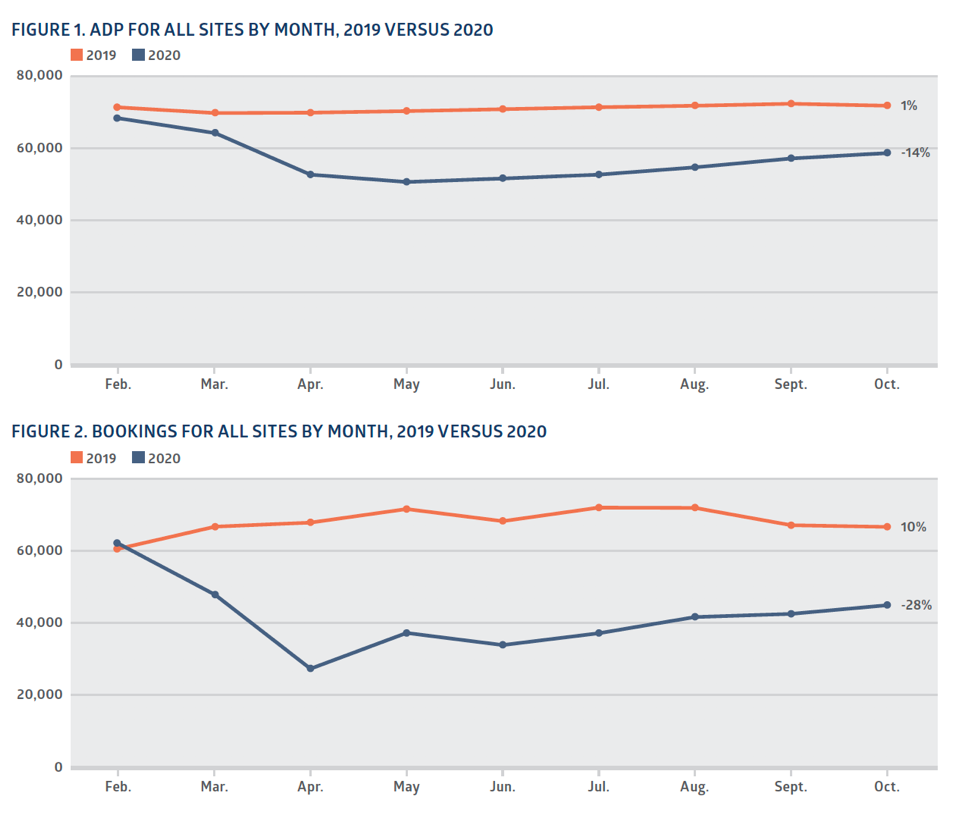COVID Data Analysis Incarceration Trends February 10, 2021
The results are in: Three years of data from Safety and Justice Challenge (SJC) sites across America show it’s possible to successfully reduce jail populations by a significant percentage.
The numbers show significant declines in overall and pretrial jail populations, and improved outcomes for people of color across the sites. Jail bookings are down, particularly for people charged with misdemeanors. But there is still work to do to build on the progress we have made. Racial and ethnic disparities persist in jail populations, and we have made limited progress on reducing length of stay and felony bookings.
Jails are intended to hold people who are awaiting court proceedings and are considered a flight risk or public safety threat. Today, 75% of people across our nation’s 3,100 local jails are being held for nonviolent offenses, and three out of five are legally presumed innocent. While many people admitted to jail are released within hours or days of their booking, many cannot afford to post bail and may remain behind bars for weeks or even months.
These and other burdens of jail fall disproportionately on communities of color: Black Americans are jailed at five times the rate of white Americans.
In 2015, the John D. and Catherine T. MacArthur Foundation launched the Safety and Justice Challenge (SJC), a multi-year initiative to reduce populations and racial disparities in American jails. To date, the SJC has provided $217 million to help 51 jurisdictions in 32 states use innovative, collaborative, and evidence-based strategies to create fairer, more effective justice systems. To track the progress of reforms in the SJC jurisdictions, the Foundation engaged the Institute for State and Local Governance (ISLG) at the City University of New York (CUNY). Our latest report focuses on performance three years into the Challenge (through April 2019). Additionally, we have released a brief examining monthly jail population trends since the pandemic struck in 2020.
Digging into the Data
Our report tracked progress in 14 jurisdictions that have submitted case-level data for analysis from May 2016 to April 2019.
From 2016 to 2019, the Average Daily Population (ADP) declined significantly across the SJC sites, especially for the pretrial population. The decrease was 18% across all sites, combined. And for those who were being held pretrial, or were waiting action on their case, the decrease was 19% across all sites, combined.
While many outcomes for people of color improved, disparities persisted. Booking rates for people of color were down 5% or more in 10 of the 14 sites.
There was also an 11% overall decline in the over-representation of People of
Color in jail for misdemeanors. Despite that progress, the booking rate for people of color relative to that of White People was down 5% or more in only three sites.
Sites have made progress reducing the representation of misdemeanors in their jails. This trend was most apparent among bookings, where nine of the 12 sites providing data reduced misdemeanor bookings by 5% or more. However, there is room for improvement on felonies: only four of the 12 saw such reductions for felony bookings.
Length of stay is mostly increasing, but the interpretation is complicated. When looking at the average length of stay at time of release, six sites saw an increase of 5% or more while four saw a decrease of 5% or more. When measuring average length of stay among everyone in jail on a given day (also referred to as the “in-custody population”), nine of the 14 sites experienced an increase in average length of stay (ALOS), with six of them experiencing an increase of 20% or more. The increase in ALOS may mean longer case processing times, but may also reflect a reduction in bookings among people who are in jail for short stays. More in-depth analysis of these trends is needed to better understand what they mean.
Recent Jail Population Trends in light of COVID-19
Throughout 2020, as the reality of the COVID-19 pandemic set in nationwide, many municipalities—including SJC sites — implemented emergency measures to reduce their jail populations. Since COVID-19, Average Daily Population (ADP) and bookings were still below pre-COVID levels in most SJC sites.
There Is Still More Work To Do
After three years of implementing strategies to reduce jail populations, our findings suggest that jail populations can, in fact, be substantially reduced; and over the last year the COVID-19 pandemic has led to even further reductions in jail populations across sites and racial and ethnic groups. With all of that said, there is room to go further, especially in reducing racial and ethnic disparities which persist and in some cases are exacerbated as jail populations decline. There will be a deepening focus on addressing these challenges as the initiative moves forward. There also needs to be more focus on length of stay, which is a huge driver of the jail population in many of the challenge sites.
The early progress represents significant cause for optimism for reducing the over-reliance on jail across America. With further progress, we expect to see a further reduction of negative impacts on communities and families.
You can download a summary of the analysis here (link). Or you can download a link to the full analysis here (link.)
—Reagan Daly is the Research Director at CUNY’s Institute for State and Local Governance.






